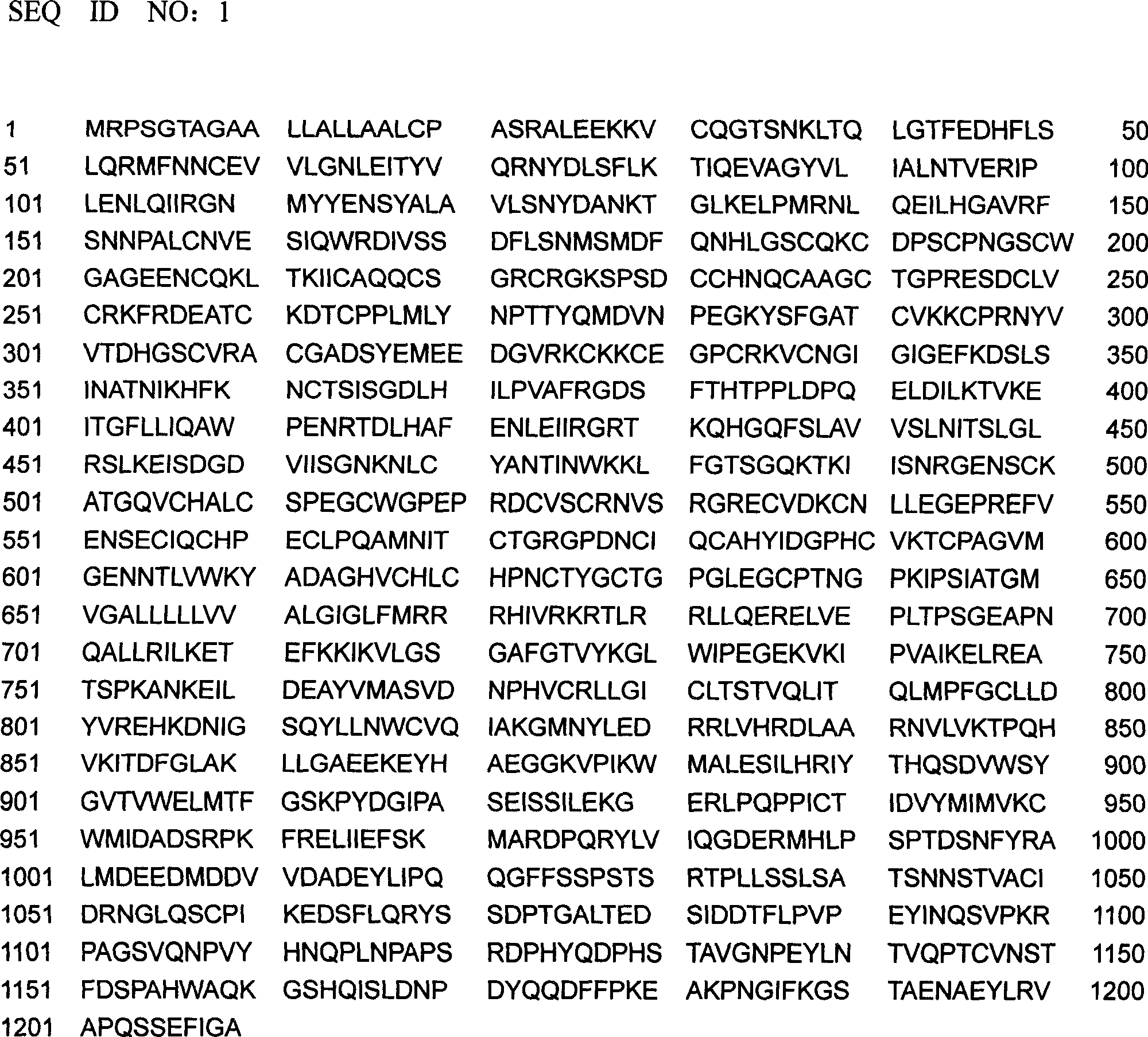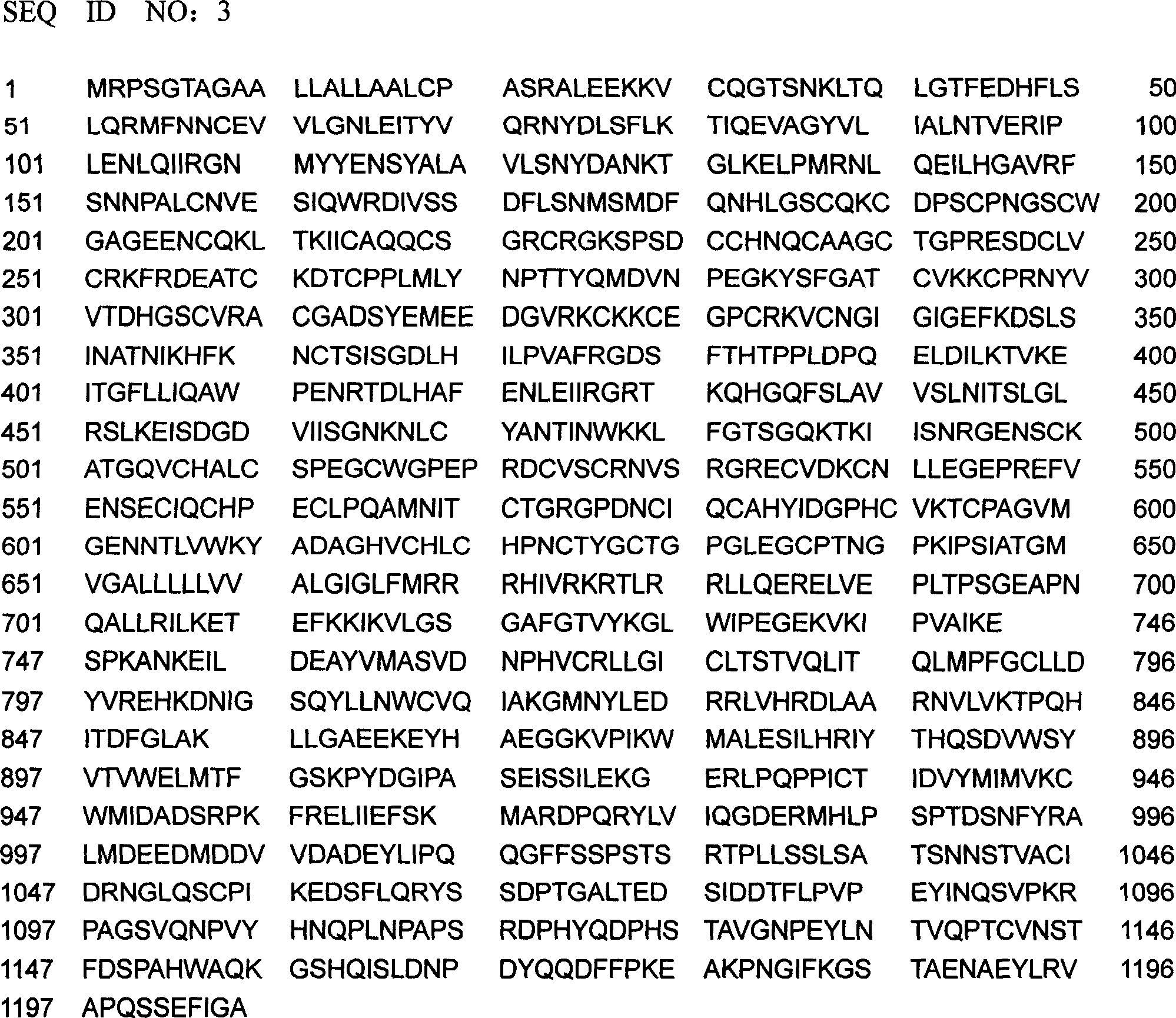Human epiterm growth-factor receptor mutation gene and use thereof
An epidermal growth factor and mutant gene technology, applied in genetic engineering, plant genetic improvement, application, etc., can solve the problems of lack of utilization, affecting the efficacy of drugs, and lack of a prognosis evaluation model for treatment methods.
- Summary
- Abstract
- Description
- Claims
- Application Information
AI Technical Summary
Problems solved by technology
Method used
Image
Examples
Embodiment 1
[0048] Example 1: Screening for gene mutations in the EGFR TK region
[0049] Screening samples mainly include: original tumor sample genomic DNA and cancer cell line cDNA.
[0050] Three pairs of primers targeting exon 19 to 21 of EGFR were designed to screen EGFR in genomic DNA. See Table 1 for details of the primers used to amplify the EGFR-TK region (tyrosine kinase region) in the cDNA of cancer cell lines.
[0051] Table 1 Primer amplification of EGFR TK exon
[0052]
[0053] Total RNA was extracted from various cancer cells using Trizol reagent. After the genomic DNA was digested with RNase-free DNaseI (purchased from TaKaRa), 5 ug of total RNA was taken for reverse transcription with SuperScrip III (purchased from Invitrogen). An appropriate amount of synthesized cDNA was used for PCR amplification of the EGFR-TK region.
[0054] In a 40 μL PCR system, the cDNA obtained corresponding to 50 ng of total RNA was used as a template and amplified with Pyrobest DNA po...
Embodiment 2
[0057] Example 2: Comparison of EGFR TK mutation frequency in NSCLC in China and other regions abroad
[0058] Genomic tumor DNA samples from 41 Chinese NSCLC patients and DNA samples from 10 non-adenocarcinoma tissues were randomly selected. Of the 41 samples, 30 were males and 11 were females. Male patients ranged in age from 43 to 77 years (mean 57 years), while female patients ranged in age from 31 to 64 years (mean 48 years). Seventeen cases were lung adenocarcinoma, 21 cases were squamous cell carcinoma, and 3 cases were adenosquamous cell carcinoma. Twenty patients had a history of smoking, while 21 had no history of smoking.
[0059] 7 human cancer cell lines used for gene mutation screening, mainly including 2 cases of lung cancer cell line 95D, NCI-H460, 2 cases of prostate cancer cell line PC-3, Du-145, and Hela, HT-1080 and MCF- 7 and other cell lines.
[0060]Table 2 Comparison of the 3 EGFR TK mutation frequencies in Chinese NSCLC with those in other foreign ...
Embodiment 3
[0062] Embodiment 3: Expression of EGFR TK region mutant gene (for example specific mutation site) in Escherichia coli
[0063] Design primers (see Table 3 for details), amplify the TK region mutant gene from the full-length gene of EGFR, clone it into the expression vector pET15b of Escherichia coli by restriction endonuclease, transform Escherichia coli DH5a to obtain the recombinant. Then, the obtained recombinant was transformed into Escherichia coli expression strain BL21 to obtain the expression strain rBL21-ETK of the mutant gene of the epidermal growth factor receptor EGFR TK region.
[0064] Table 3 EGFR TK region mutant gene amplification primers
[0065]
[0066] Inoculate the strain rBL21-ETK, grow it to OD0.8, add IPTG at a final concentration of 1mM, induce expression for 4 hours, collect the bacteria by centrifugation, add lysis buffer to resuspend, and then perform ultrasonic lysis in an ice bath . After breaking the bacteria, the centrifuged precipitate w...
PUM
 Login to View More
Login to View More Abstract
Description
Claims
Application Information
 Login to View More
Login to View More - R&D
- Intellectual Property
- Life Sciences
- Materials
- Tech Scout
- Unparalleled Data Quality
- Higher Quality Content
- 60% Fewer Hallucinations
Browse by: Latest US Patents, China's latest patents, Technical Efficacy Thesaurus, Application Domain, Technology Topic, Popular Technical Reports.
© 2025 PatSnap. All rights reserved.Legal|Privacy policy|Modern Slavery Act Transparency Statement|Sitemap|About US| Contact US: help@patsnap.com



